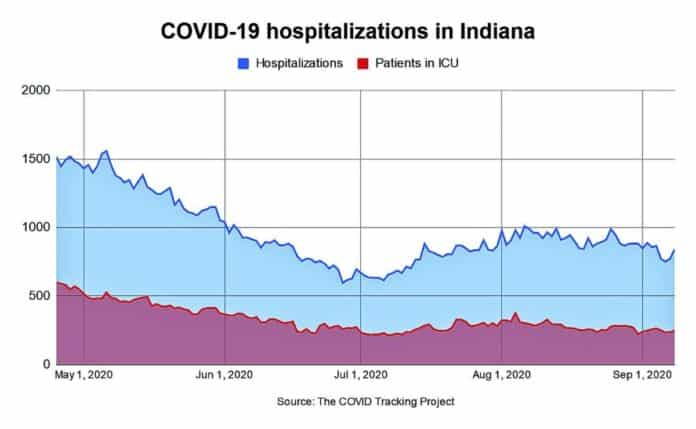As fall approaches, health officials around the country, including in Bartholomew County, are concerned about how the COVID-19 pandemic will evolve once flu season kicks into high gear.
Both influenza and the novel coronavirus likely will circulate in Bartholomew County this fall and winter, and complicating matters further, symptoms of both illnesses — dry cough, fever and chills, fatigue — are difficult to distinguish without testing.
Local officials worry that a wave of flu patients could overwhelm hospitals, doctor offices and laboratories that test for both illnesses and other resources that may already be in shorter supply if there is another rebound in COVID-19 patients.
The end results, according to local health officials, could be “catastrophic”— particularly if people flout public health guidance aimed at reducing the spread of the coronavirus, including wearing masks, avoiding crowds and keeping their distance.
[sc:text-divider text-divider-title=”Story continues below gallery” ]
“If we as a community let down our guard, we could see a catastrophic combination of COVID-19 and influenza activity at the local level,” said Dr. Brian Niedbalski, Bartholomew County health officer. “We would see possible school closures, business closures and a repeat of last spring with cancellations of sporting events, concerts, graduations, etc.”
Flu vaccines
This year, Bartholomew County health officials say it is more important than ever to get a flu shot, which they say will reduce the risk of illness, hospitalization or death from flu — and free up resources for COVID-19 patients.
The seasonal flu is an acute respiratory illness caused by influenza viruses that is spread by respiratory droplets made when an infected person coughs, sneezes or talks, according to the Centers for Disease Control and Prevention. The ailment can vary in severity and potentially be fatal.
Influenza viruses typically circulate in the northern hemisphere between October and March, though flu activity usually peaks in the United States between December and February, according to the CDC.
Local health officials advise people to get a flu shot by the end of October and get vaccinated early because it can take up to two weeks for the body to develop antibodies against the flu after vaccination.
Though COVID-19 is significantly more deadly than the flu, influenza and pneumonia are currently listed as the eighth leading cause of death in the United States, according to the CDC. This past flu season, influenza was responsible for 39 million to 56 million illnesses and 24,000 and 62,000 deaths, CDC estimates show.
A total of 183 Bartholomew County residents died from influenza or pneumonia during a 15-year period from 2003 to 2017, according to the latest figures available from the Indiana State Department of Health.
By comparison, at least 56 Bartholomew County residents have died from COVID-19 since April.
“This year is going to be particularly difficult because the symptoms of influenza and COVID are very similar, and it will be nearly impossible to differentiate the two without specific testing for both viruses,” said Dr. Lindsay Anderson, a physician specializing in internal medicine at Columbus Internal Medicine Associates. “If we’re not able to vaccinate enough people for influenza, there’s a good chance that the health care system could be overloaded with patients who have acute respiratory illnesses, either due to influenza or COVID.”
Additionally, public health officials have not ruled out the possibility that people can get infected with COVID-19 and influenza at the same time.
“There’s absolutely a concern about co-infection with influenza and COVID,” Anderson said. “We know that with COVID, people’s respiratory system can become very, very ill, and if you add a secondary infection to that, I think the results could be devastating.”
National effort
The local concerns come amid a nationwide effort led by the CDC to dramatically increase flu vaccinations this year and inoculate a record number of people in the United States, The Associated Press reported.
To meet the increased demand for flu vaccines, drugmakers plan to supply U.S. healthcare providers with a record 194 to 198 million doses of flu vaccines this season, according to the CDC.
The hope is that the vaccines will prevent millions of illnesses and thousands of hospitalizations and deaths from flu and ease the burden on hospitals that are bracing for a rebound in COVID-19 patients.
This past season, the flu was responsible for 18 million to 26 million medical visits and 410,000 to 740,000 hospitalizations, CDC estimates show. Currently, there are around 30,000 people hospitalized with COVID-19 in the United States, according to the COVID Tracking Project.
Last month, CDC Director Robert Redfield said in an interview with WebMD that the United States could be on the verge of “the worst fall, from a public health perspective, we’ve ever had.”
“We’re going to have COVID in the fall, and we’re going to have flu in the fall,” Redfield told WebMD. “And either one of those by themselves can stress certain hospital systems.”
Just 49.2% of American adults and 62.6% of children got the flu shot during the 2018-19 flu season, including just 45.3% of adults and 56.6% of children in Indiana, according to the latest figures available from the CDC.
Locally, health officials hope as many people as possible get vaccinated, especially patients who are at a higher risk of severe illness, Anderson said.
“The population particularly at risk for some of the complications related to influenza would be our patients who are over 65, young children, pregnant women and anybody with chronic health conditions like diabetes, heart failure, cancer,” Anderson said. “I would hope that we could get all of those people vaccinated at a bare minimum.”
Uncertainty
Much is still unknown about how SARS-CoV-2, the virus that causes COVID-19, will behave in colder weather, but many viruses— including influenza viruses — are more prevalent during colder months.
Public health scientists say it’s exceedingly difficult to forecast how the coronavirus pandemic will play out this fall, according to wire reports. School reopenings, holiday travel and more indoor activity because of colder weather could all separately increase transmission of the virus and combine in unpredictable ways.
“There is quite a bit of uncertainty in how COVID-19 numbers will look in the fall,” Niedbalski said. “Many viruses, including influenza, are more prevalent in the cold weather months. Will this coronavirus act the same way? That’s why social distancing, wearing masks and proper hand washing will be so important for a least the next six months.”
Over the past few weeks, the number of Americans newly diagnosed with the coronavirus has been declining since peaking in late July, a development experts say most likely reflects more mask-wearing but also insufficient testing, according to wire reports.
However, one widely cited model from the University of Washington’s Institute of Health Metrics and Evaluation projects that decline may be short lived.
The model also forecasts a dramatic increase in the number of U.S. daily deaths from COVID-19, reaching over 2,800 by Thanksgiving, including about 35 daily deaths in Indiana, which is more than triple what they are today.
But if mask use is increased to 95%, the model states, the number of U.S. daily deaths would stay largely the same by Thanksgiving, and daily deaths in Indiana would fall to about five.
Local health officials are urging people to take COVID-19 seriously, wear masks and follow social distancing guidelines.
“The unknown of the future is what worries me the most,” Anderson said. “I also get concerned when I hear that there are still people who don’t believe that the COVID pandemic is real. As a frontline worker, I’m seeing it every day, and I wish people would understand the full impact that we’re seeing as physicians.”
[sc:pullout-title pullout-title=”CRH drive-thru flu shot clinic” ][sc:pullout-text-begin]
Columbus Regional Health is offering drive-thru flu shots this fall for safety and convenience during the pandemic in an effort to encourage people to get vaccinated this year.
The drive-thru clinic, which started last week at PromptMed, 2502 25th St., will operate Wednesdays and Thursdays this fall and is only available by appointment for patients who have a CRH primary care provider, said CRH spokeswoman Kelsey DeClue.
CRH patients who wish to schedule a drive-thru flu shot should call their primary care office to ask to make a drive-thru flu shot appointment at the designated site, though physicians may advise different arrangements for flu shots on a case-by-case basis, DeClue said.
[sc:pullout-text-end]





